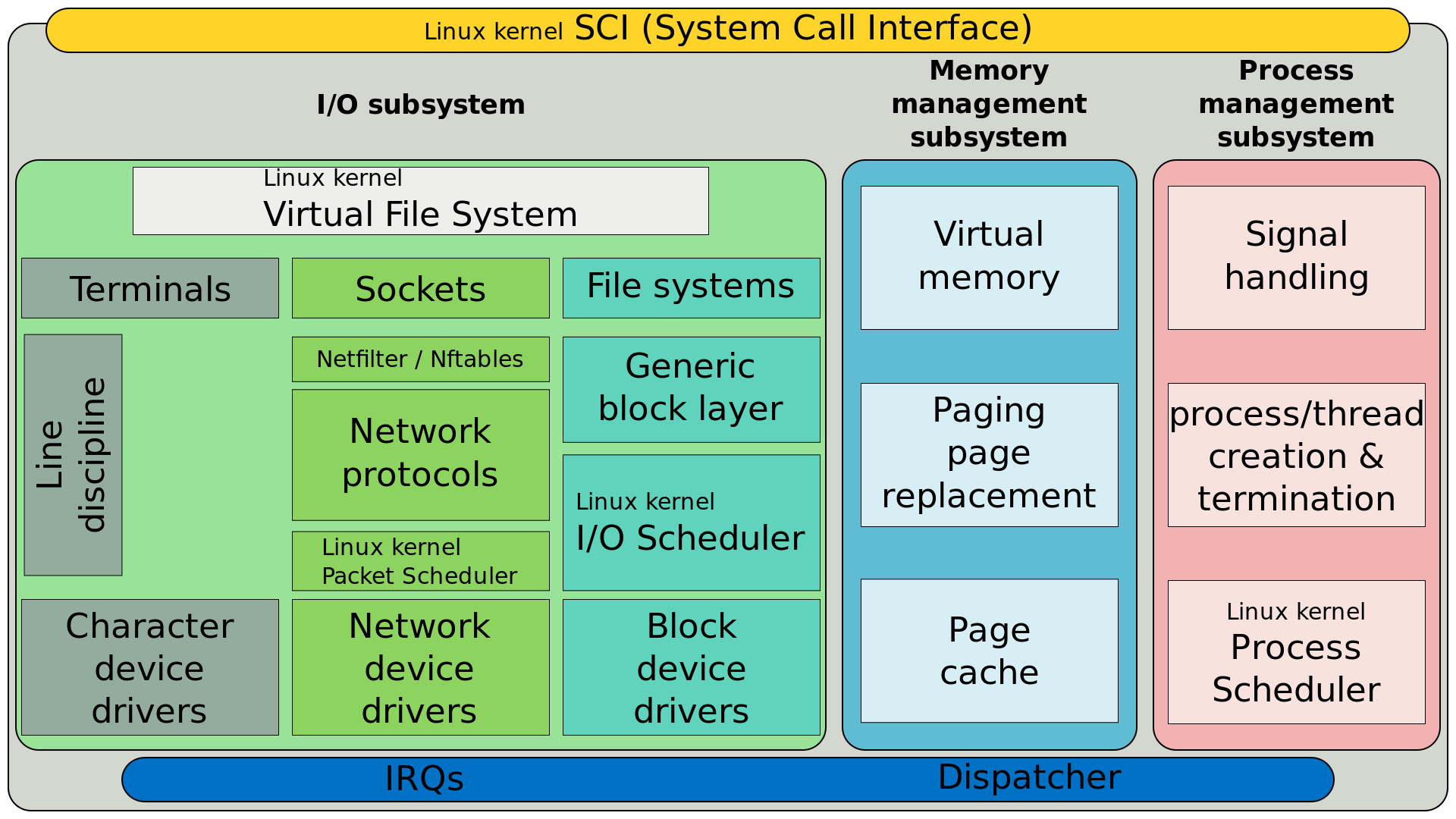X.1: Real-time Operating Systems
Operating Systems
In the previous chapters, many aspects are handled that form the Operating System. The image below, linked from Wikipedia, shows the most important components in the Linux kernel.

source: wikipedia.com
The image above shows:
- Task management
- Memory management
- the IO subsystem

The desired situation.

The real situation.
The main goal of the OS is still the same: allow multiple programs and/or users use the same hardware. On the left-hand side of the image above a visual representation is given of what we want to experience. Everything is running truly in parallel. We have touched on a number of reasons why reality is more like is shown on the right-hand side of the image. The OS will do its best to achieve the desired situation as good as possible. However, sometimes doing your best is not good enough.
Try to imagine these situations (and the possible explanations from the developers):
- A pacemaker missed an arrhythmia
- Sorry, at that moment the tiny OS was switching tasks.
- A surveillance drone crashed against a construction crane
- Sorry, at that moment the drone should have detected the crane, the flight computer was in the middle of a TCP time-out while sending telemetry.
- The motor of a high-end sports car burned out due to a faulty-timed gear shift
- Sorry, at the moment the timer ended, the microcontroller was handling a switch in radio stations.
Sometimes, doing your best is not good enough.
Real-time Operating Systems
While a general OS tries its best to meet all constraints, a sporadic failure is not a vital problem. If there is a dip in network handling resulting in a short lag of a youtube-clip the computer will not crash-and-burn. Operating systems like this are called soft real-time operating systems and examples are: Linux, Windows, iOS, …
Like illustrated above, some situations have tasks which have to meet their constraints. Failing to do so results in a system failure. For these applications Real-Time Operating Systems (RTOS) can be used. These operating systems are called hard real-time systems. They have very specific deterministic constraints and ALL of them should be MET, at ALL TIME. Examples of RTOSes are:
- FreeRTOS
- mbedOS
- Contiki
- Xenomai
- (there are many more)
For the sake of completeness it is pointed out that tweaks are available to turn the Linux kernel into a real-time kernel.
FreeRTOS
FreeRTOS is an open source real-time OS that is tailored for embedded systems. You can even run this on an Arduino.
This OS essentially consists out of merely 5 files:
- tasks.c: handles task management
- queue.c: handles queues & synchronisation
- list.c: handles lists
- port.c: details for porting to a specific processor
- heap_x.c: handles the heap
FreeRTOS is a trade-off between bare-metal programming and the luxury of an OS. With everything you’ve seen in this course you should be able, after some studying perhaps, to understand how a task is described.
void runClock(void* pvParameters) {
short i, j, k, l;
for/*ever*/(;;) {
for(i=0;i<24;i++){
for(j=0;j<60;j++){
d[0]= j % 10;
d[1]= (j-d[0]) / 10;
d[2]= i % 10;
d[3]= (i-d[2]) / 10;
for(k=0;k<10;k++) {
for(l=0;l<4;l++) {
_delay_ms(5);
}
}
}}
} /* end of for/*ever*/
// no return statement
}
The function above is the program/tasks that simulates time. The time is written in shared memory that is accessible by other programs/tasks.
The main function could like this:
int main(void) {
/* Perform any hardware setup necessary. */
// define the outputs to be the 4 digit-selectors and the 7 segement-selectors
DDRB |= 0b00111111;
DDRD |= 0b11111000;
/* APPLICATION TASKS CAN BE CREATED HERE
* eg. xTaskCreate(TaskBlinkGreenLED, (const portCHAR*) "GreenLED", 256, NULL, 3, NULL);
* with 1st argument: name of the function
* 2nd argument: human readable name (only for debugging purposes)
* 3rd argument: stacksize (in "words" (words*stackwidth = memory))
* 4th argument: function parameters
* 5th argument: priority (0 ... (configMAX_PRIORITIES – 1))
* 6th argument: pxCreatedTask can be used to pass out a handle to the task being created. This handle can then
* be used to reference the task in API calls that, for example, change the task priority or
* delete the task.
**/
xTaskCreate(runClock, (const portCHAR*) "runclock", 256, NULL, 3, NULL);
xTaskCreate(showOnDisplay, (const portCHAR*) "displayer", 256, NULL, 3, NULL);
/* start the scheduler */
vTaskStartScheduler();
/* Execution will only reach here if there was insufficient heap to start the scheduler. */
for/*ever*/ (;;);
return 0;
}
Is a RTOS outdated?
One could state that RTOS-es are outdated. Processors and OS-es, anno 2023, are so powerful that no additional measures should be taken to guarantee specific constraints. While that might be true, there is also scalability.
It might be feasible to write all the desired software (networking stacks, logging, sensor reading, …) in such a way all constraints are met, BUT it requires a state-of-the-art system. For example: a processor with 2 GB of RAM memory and 160 GB of solid state storage. Installing this in every gearbox of a car, for example, simply is too expensive. If the same constraints and performance requirements can be met for a fraction of the price, industry dictates the latter option should be chosen.
That’s good news for whoever is studying this course, as skill-full programmers and engineers are a necessity to make this work!
